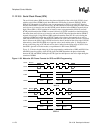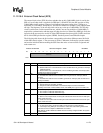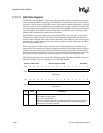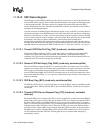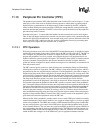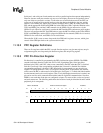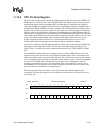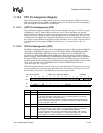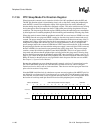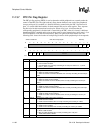
SA-1100 Developer’s Manual 11-185
Peripheral Control Module
Serial port 1 and serial port 4 both contain two serial-to-parallel engines that operate independently.
However, because each port contains only one set of serial pins, the user can assign these pins to
only one of the two protocols at a time. To allow the user to utilize both protocols, the PPC can
assign one of its two serial-to-parallel engines to the pins that are dedicated to the port, and the
other to a set of GPIO pins. Serial port 1 contains an SDLC and a UART. By setting a bit in the
PPC and the appropriate GAFR and GPDR bits in the GPIO unit, SDLC operation defaults to the
TXD1 and RXD1 pins, and the UART transmits via the GPIO<14> pin and receives via the
GPIO<15> pin. Likewise, serial port 4 contains the MCP and the SSP synchronous serial engines.
The user can configure the PPC and GPIO units to cause the MCP to default to the TXD4, RXD4,
SCLK, and SFRM pins, and the SSP is assigned to GPIO<10> for transmit, GPIO<11> for receive,
GPIO<12> for serial clock, and GPIO<13> for serial frame.
When the SA-1100 is reset or enters sleep mode, the GPIO unit’s registers are reset, which gives
control of the GPIO pins back to the system control module.
11.13.2 PPC Register Definitions
There are five registers within the PPC: one pin direction register, one pin state register, one pin
assignment register, one sleep mode pin direction register, and one pin flag register.
11.13.3 PPC Pin Direction Register
Pin direction is controlled by programming the PPC pin direction register (PPDR). The PPDR
contains individual direction control bits for 22 of the 24 peripheral pins. Serial port 0 has
dedicated pins (UDC+ and UDC-) that are not controlled by the PPC when the UDC is disabled.
Each bit is used only if the corresponding peripheral that it controls is disabled. Provided the
corresponding peripheral is disabled, if the direction bit is programmed to a one, the pin is an
output. If it is programmed to a zero, it is an input. Following reset, all peripherals are disabled,
which causes the PPC to take control of all of their pins. Serial ports 1..3 contain individual enables
for their transmit and receive serial engines. Thus, if only half-duplex transmission is needed, one
pin can be used for serial communication and the other for digital I/O communication. Note that
PPDR is reset such that all the pins are configured as inputs. For reserved bits, writes are ignored
and reads return zero. The following table shows the location of each pin direction bit and to which
peripheral pin it corresponds.
Address: 0h 9006 0000 PPDR: PPC Pin Direction Register Read/Write
Bit 31302928272625242322212019181716
Reserved
SFRM SCLK RXD4 TXD4 RXD3 TXD3
Reset0000000000000000
Bit 1514131211109876543210
RXD2 TXD2 RXD1 TXD1
L_
BIAS
L_
FCLK
L_
LCLK
L_
PCLK
LDD
<7>
LDD
<6>
LDD
<5>
LDD
<4>
LDD
<3>
LDD
<2>
LDD
<1>
LDD
<0>
Reset0000000000000000




